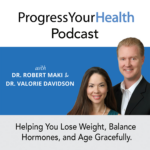

Michelle’s Question: Hi, thank you so much for sharing your knowledge with us!
In March 2022 at 42 years old, I had a total hysterectomy with bilateral salpingo-oophorectomy because of stage 4 endometriosis, grapefruit-sized fibroids, ovarian cysts, and my left ovary adhered to my colon.
I was immediately put on an estradiol patch. I was recovering and doing well until the beginning of June. Then I started having hot flashes, 24/7 anxiety, insomnia, and not feeling well every day.
Since March, my dosage has gone from .25, .5, .75, and 1 mg. But I saw no improvement in my symptoms and have said this was the worse summer of my life.
I am debilitated by it. After much research, I decided to try bio-identical creams that have estriol, estradiol, progesterone, pregnenolone, and DHEA.
Even though I no longer have a uterus, I know that my body is used to having these hormones and am hoping they help me get through this surgical menopause and be able to function again. Is this a combo hormone protocol you’ve ever done for your patients?
If so, should I apply estriol and estradiol in the morning, and progesterone, pregnenolone, and DHEA at night?
Short Answer:
Surgical menopause is much different from what you could call your typical menopause. Honestly, there is nothing typical about menopause. Some women breeze through menopause and others have symptoms so severe it can seriously affect their quality of life, not to mention the people around them. And I (Dr. Davidson) can say this honestly, being just shy of 50 and feeling the effects of menopause. But being that I am a hormone doctor, I have some advantages to easing my transition. This is why we do what we do, here at Progress Your Health Inc. We know that hormone imbalance can alter how you feel. From your energy to your sleep, to your libido (or lack of) and more. Hormones can even affect your actual overall health.
Menopause is when the ovaries naturally start to decline and then cease producing hormones. Those hormones in particular are estrogen (estradiol) and progesterone. Menopause is a natural part of life. Those ovaries have worked well for a long time and are ready to retire, naturally so. Making that transition is where we come in. Helping with lifestyle, supplementation, and even medication to help the process.
Now surgical menopause is an entirely different story. In natural menopause, the ovaries start to decline and eventually cease hormone production. In surgical menopause, the ovaries are surgically removed. In an instant, you go from making hormones (estrogen and progesterone), to making absolutely none. This is a huge change. In a flash, a woman goes from producing hormones to an abrupt stop.
In most cases, the removal of the ovaries is necessary. Perhaps there is endometriosis where the ovaries have adhered to the abdominal wall, uterus, and/or colon. Or there are so many complicated cysts causing a tremendous amount of pain. There can be many reasons for an oophorectomy (removal of the ovaries). At this point, there is usually a hysterectomy (removal of the uterus) as well. As the uterus could have fibroids, polyps, and thickened lining. But in any case, removing the ovaries will put a cycling woman (having her period and usually in her 40s) into instant menopause.
After surgical menopause (depending on the reason for the removal of the ovaries), it is usually necessary to implement hormones. That being said, the abrupt decline of hormones can cause a woman to feel absolutely awful. From horrible hot flashes to not getting any sleep due to night sweats. There is weight gain seemingly overnight, hair loss, loss of libido, and vaginal dryness. Brain fog to the point of word recall being horribly embarrassing.
The thing with surgical menopause is dosing. In surgical menopause, you need to make sure to get the right dose for the individual to get a positive effect. Most docs end up starting too low when using bio-identical hormones (which unfortunately can give BHRT a bad name). BHRT can be amazing. But if not dosed well, it seems like, well, nothing. Many times, women are given an estrogen patch after surgical menopause. An estrogen patch is made up of estradiol. Which usually can actually be too strong. Being that it causes an instant 8-15 lbs of weight gain overnight and symptoms of estrogen dominance (which is a whole other podcast/blog post).
What we use for surgical menopause is Biest. Biest is a combination of estradiol and estriol. The estriol has a more gentle effect and helps buffer some of the strength (or side effects) of estradiol. But in the case of Biest, as mentioned before, it is about dosing. The difference between a conventional estradiol patch and Biest is like apples and oranges. The dosing is so different. So many women get underdosed with Biest. There are many ways to dose BHRT. It is so individualized that in our practice rarely are patients on the same dose. Everyone has their own individual doses based on their goals, health history, family history, and lifestyle. In some cases, we will do rhythmic dosing. Which is cycling hormone doses based on a natural 28-day cycle. As I mentioned, everyone is so unique that their BHRT dose is unique as they are.
Another unfortunate factor in surgical menopause is doctors’ neglect to implement progesterone. There is a conventional philosophy that if there is no uterus, there is no need for progesterone. But we firmly (very firmly) believe that progesterone is necessary for more than just a uterus. Progesterone has so many positive benefits. Such as helpful for irritability/mood and for breast protection for hair and skin (again, the benefits of progesterone is another podcast/blog).
As I said, surgical menopause is different from natural menopause. But it can be addressed in a way that can be incredibly helpful. If you have any questions, please contact us.
Other Related Episodes:
Episode 117 – Can Ovarian Failure Be Treated?
Episode 108 – What Should Esradiol Level be on BHRT?
Episode 1
The post Is Surgical Menopause Worse Than Natural Menopause? | PYHP 121 appeared first on .
Discover the common and unfamiliar symptoms that you might be experiencing. Get access to cases of real women with hormonal conditions.

In this episode, we return to a listener’s question regarding thyroid dosing in perimenopause. In our previous episode, we answered Tracy’s question about taking estrogen in perimenopause. Tracy also asked us an additional question about her thyroid doses. Tracy does not have a thyroid gland and has been noticing her dose is continually increasing as […]
In this episode, we discuss a listener’s question regarding perimenopause and estrogen hormone replacement. Tracy is concerned because she is still having a period but also has symptoms of low estrogen. She is not sure if she is a candidate for estrogen therapy since she is still cycling. Tracy’s Question: Hi- you’ve discussed in past […]
In this episode we discuss Jenell’s question she submitted on our website (Ask the Dr). Jennell has been having terrible anxiety since entering menopause and it is really affecting her quality of life. Jenell’s Question: Since starting menopause, I’ve had debilitating anxiety, especially bad in the morning. By evening, It practically goes away. I’m 54 […]
In this episode, we discuss a listener’s question. Amanda is 50 years old and starting to have menopausal hot flashes and weight gain. However, she is most concerned about the heart palpitations she is having. Amanda has had a cardiovascular workout and does not have heart disease. Most people might not be aware, but feeling […]
In this episode, we discuss a listener’s question about perimenopause. ‘Maggie’ is in her 40’s and experiencing severe insomnia with anxiety. She has tried supplements and different doses of progesterone with minimal results. She is having so many ups and downs with her insomnia, anxiety, and hormones. She is wondering how long this is going […]
In this episode, we talk about Mary’s hormone concerns after ovarian failure. She is only 34, and in the last 7 years since her ovarian failure has tried many hormone replacement options, all without the success she was looking for. Let’s Read Mary’s Question: When I was 27 years old I was diagnosed with iatrogenic […]